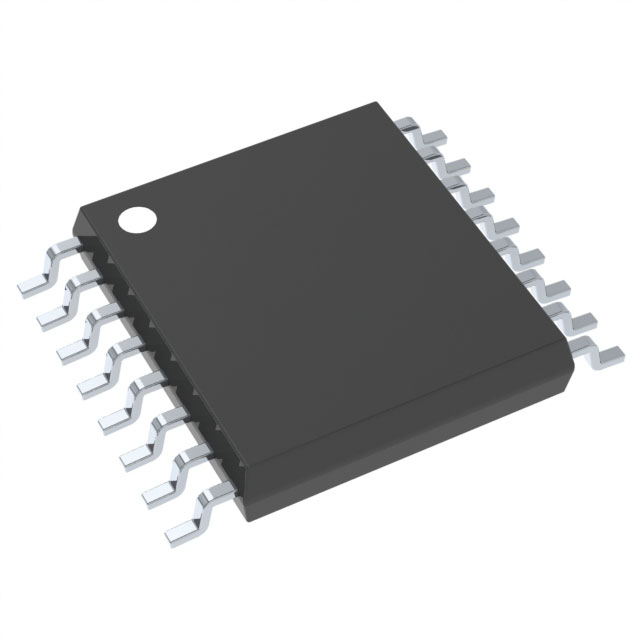CD4021BPWR
Product Overview
Category
CD4021BPWR belongs to the category of integrated circuits (ICs).
Use
This product is commonly used for parallel-to-serial data conversion in various electronic applications.
Characteristics
- CD4021BPWR is a CMOS 8-stage static shift register.
- It operates at a wide voltage range, typically between 3V and 18V.
- The IC has a high noise immunity and low power consumption.
- It offers a wide operating temperature range, making it suitable for various environments.
Package
CD4021BPWR is available in a small outline package (SOIC) with a width of 3.9mm.
Essence
The essence of CD4021BPWR lies in its ability to convert parallel data into serial data, enabling efficient data transmission and storage.
Packaging/Quantity
This product is typically packaged in reels, with each reel containing 2500 units.
Specifications
- Supply Voltage: 3V - 18V
- Input Voltage: 0V - VDD
- Output Voltage: 0V - VDD
- Operating Temperature Range: -55°C to +125°C
- Maximum Clock Frequency: 5MHz
Detailed Pin Configuration
CD4021BPWR consists of 16 pins, each serving a specific purpose:
- Serial Data Input (DS)
- Parallel Data Output (QH')
- Clock Input (CP)
- Master Reset (MR)
- Serial Data Output (QH)
- Parallel Data Input (D0)
- Parallel Data Input (D1)
- Parallel Data Input (D2)
- Parallel Data Input (D3)
- Parallel Data Input (D4)
- Parallel Data Input (D5)
- Parallel Data Input (D6)
- Parallel Data Input (D7)
- Supply Voltage (VDD)
- Ground (GND)
- Clock Enable (CE)
Functional Features
- CD4021BPWR can be cascaded to achieve a higher number of parallel-to-serial conversions.
- It has a built-in master reset function for clearing the register.
- The IC operates with a single clock input, making it easy to integrate into various systems.
Advantages and Disadvantages
Advantages
- Wide operating voltage range allows for compatibility with different power sources.
- Low power consumption makes it suitable for battery-powered devices.
- High noise immunity ensures reliable data transmission in noisy environments.
Disadvantages
- Limited maximum clock frequency may restrict its use in high-speed applications.
- Lack of built-in error detection or correction mechanisms.
Working Principles
CD4021BPWR functions by shifting the parallel data input into its internal shift register upon receiving clock pulses. The converted serial data is then available at the serial data output pin. The master reset pin clears the register when activated.
Detailed Application Field Plans
CD4021BPWR finds applications in various fields, including:
- Industrial automation: Used for data acquisition and control systems.
- Communication systems: Enables efficient data transmission and reception.
- Consumer electronics: Integrated into devices requiring parallel-to-serial conversion.
- Automotive electronics: Utilized in vehicle control units and infotainment systems.
Detailed and Complete Alternative Models
Some alternative models that offer similar functionality to CD4021BPWR include:
- SN74HC165N
- CD4094BE
- 74HC595N
- CD4015BE
These alternatives can be considered based on specific project requirements and availability.
Word count: 550 words
Senaraikan 10 soalan dan jawapan biasa yang berkaitan dengan aplikasi CD4021BPWR dalam penyelesaian teknikal
Sure! Here are 10 common questions and answers related to the application of CD4021BPWR:
Q1: What is CD4021BPWR? A1: CD4021BPWR is a CMOS 8-stage static shift register commonly used in technical solutions for parallel-to-serial or serial-to-parallel data conversion.
Q2: What is the maximum clock frequency supported by CD4021BPWR? A2: CD4021BPWR can support clock frequencies up to 5 MHz.
Q3: How many input pins does CD4021BPWR have? A3: CD4021BPWR has 8 input pins, which can be used to read parallel data.
Q4: Can CD4021BPWR be cascaded to increase the number of inputs? A4: Yes, CD4021BPWR can be cascaded to increase the number of inputs. By connecting the output of one CD4021BPWR to the input of another, you can expand the number of inputs as needed.
Q5: What is the power supply voltage range for CD4021BPWR? A5: CD4021BPWR operates with a power supply voltage range of 3V to 18V.
Q6: Does CD4021BPWR have an internal pull-up resistor? A6: No, CD4021BPWR does not have an internal pull-up resistor. External pull-up resistors may be required if using open-drain outputs.
Q7: What is the typical power consumption of CD4021BPWR? A7: The typical power consumption of CD4021BPWR is around 10µW.
Q8: Can CD4021BPWR be used for debouncing switches? A8: Yes, CD4021BPWR can be used for debouncing switches. By connecting switches to the input pins, you can debounce the switch signals using the shift register.
Q9: What is the output format of CD4021BPWR? A9: CD4021BPWR outputs data in a serial format, with the most significant bit (MSB) being shifted out first.
Q10: Can CD4021BPWR be used for LED matrix control? A10: Yes, CD4021BPWR can be used for LED matrix control. By connecting the output pins to the rows or columns of an LED matrix, you can control the display using the shift register.
Please note that these answers are general and may vary depending on specific application requirements.


